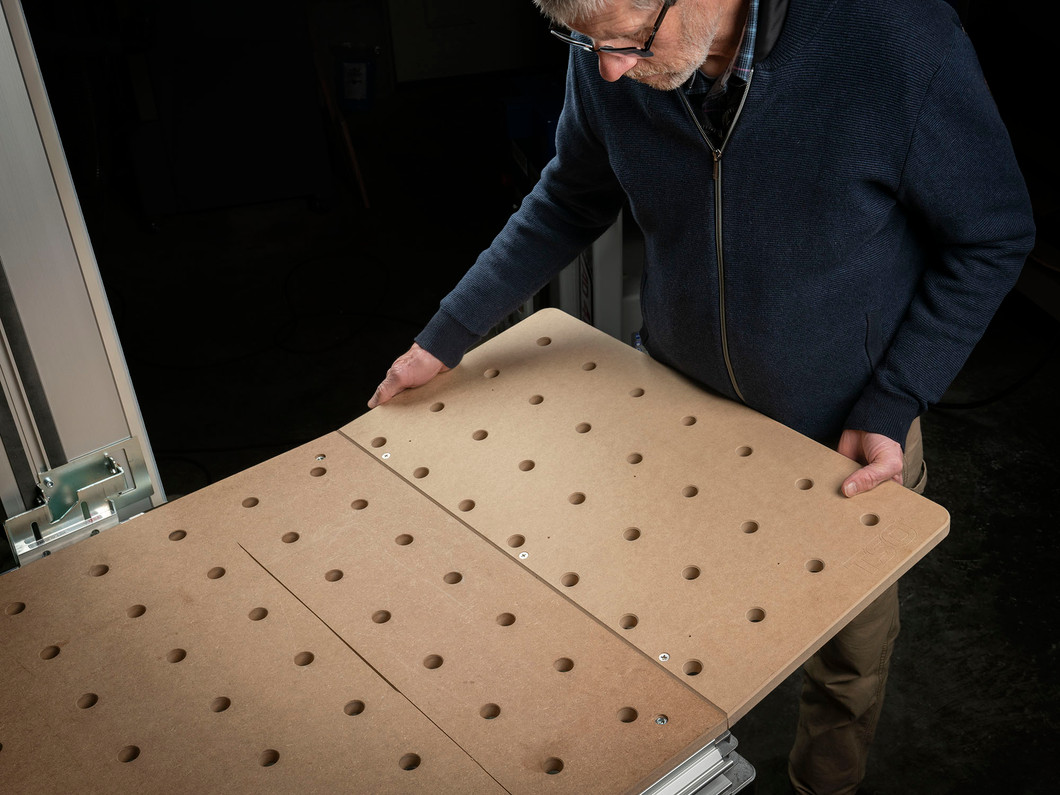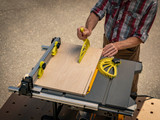Build Your Own MFT Workbench: Complete MFT DIY Guide
The Multi-Function Table—or MFT workbench as many call it—has become the Swiss Army knife of modern workshops. Originally developed by Festool, this perforated work surface transforms how you approach precision cutting, assembly, and project layout.
While commercial MFT tables deliver excellent performance, creating your own custom MFT setup gives you real advantages: complete customization to fit your space and workflow, the ability to integrate features that manufacturers charge extra for, and a workbench built exactly to your specifications—the right height, width, and storage for how you actually work.

MFT Workbench Basics
An MFT workbench centers around a flat surface perforated with a grid of 20mm holes spaced 96mm apart—a spacing that creates incredible versatility for workholding and precision operations. The holes accept bench dogs, clamps, track saw guides, and specialized accessories that transform a simple table into a complete work system.
Primary functions include:
- Precision cutting: Track saws reference off the hole grid for repeatable, square cuts
- Assembly and glue-ups: Dogs and clamps hold components in perfect alignment
- Routing operations: The perforated surface provides dust collection and secure workholding
- Sanding and finishing: Holes allow airflow and dust extraction while supporting workpieces
Why create your own custom setup? Whether you're modifying an existing commercial table or building from scratch, customization lets you control dimensions, height, storage integration, and features that manufacturers either don't offer or charge premium prices for. You can add router extensions, dust collection ports, and tool storage exactly where your workflow needs them.
Planning Your Custom Setup
Before diving into modifications or construction, take an honest look at how you actually work. The best MFT setup is the one that matches your real workflow, not an idealized version of how you think you should work.
Space and dimension considerations drive everything else. Measure your available floor space, but also consider ceiling height for dust collection and lighting. A 30"×48" surface handles most projects while fitting through doorways, but don't default to standard sizes if your space or projects demand something different. Compact shops might benefit from a 24"×36" portable version, while dedicated woodworking spaces can accommodate 36"×60" or larger surfaces.
Height matters more than most realize. Standard 34-36" workbench height works well for assembly tasks, but track saw work often benefits from slightly lower surfaces (32-33") to reduce arm fatigue during extended cutting sessions. Consider your primary use and adjust accordingly…your back will appreciate the thought.
Workflow analysis reveals upgrade priorities. Do you frequently switch between routing and assembly? Plan for integrated router extensions. Spend lots of time with track saws? Prioritize guide rail support systems. Work with dusty materials? Design dust collection into the base rather than adding it later.
Your customization path depends on what you're starting with. Already own a commercial MFT? You might simply need to add storage, modify the height, or integrate accessories. Starting fresh? You can build exactly what you need from the ground up. Many woodworkers find success with hybrid approaches—using a commercial top with a custom base, or building a custom top to fit an existing workbench frame.
The key is matching your investment to your actual needs rather than building features you'll rarely use.

Materials and Process
Creating Your Custom MFT
Essential materials depend on your approach. For custom tops, three-quarter-inch MDF provides the best balance of cost, stability, and clean hole-drilling characteristics. Base options range from simple 2×4 frames to torsion box construction using 2×2 lumber and plywood skins.
Key tools include a drill press or accurate handheld drill, sharp 20mm Forstner bit, track saw or table saw for sizing, and quality measuring tools. A drilling template ensures consistent hole spacing—this isn't the place to eyeball measurements.
Commercial starting points offer proven foundations for customization. The Festool MFT/3 remains the gold standard with its precision-manufactured top, adjustable height, and integrated clamping elements. While pricier than DIY alternatives, it provides a rock-solid foundation that you can modify with custom storage, extensions, or workflow-specific additions without questioning the base quality.
The process varies by scope. Modifying existing tables might involve adding storage shelves, dust collection ports, or accessory mounting. Building custom tops requires careful layout of the 20mm hole grid at exactly 96mm spacing—small errors here multiply across the entire surface. Complete builds add base construction, which must prioritize stability and levelness above all else.
Precision cannot be compromised in hole placement and surface flatness. A wobbly or inaccurate table defeats the entire purpose of the MFT system. Take time to get these fundamentals right, and everything else becomes straightforward.

Professional Upgrades
TSO Accessories for Enhanced Performance
We might’ve mentioned briefly already, but TSO’s strategic upgrades transform many MFT setups and are worth taking a look at.
Router Table Extension for MFT/3 adds professional routing capabilities without requiring separate equipment. The extension integrates seamlessly with the hole grid for consistent workholding during routing operations.
Table Extension for MFT/3 doubles your work surface when projects demand it, then folds away for normal operations. Particularly valuable in smaller shops where permanent large surfaces aren't practical.
Tool Shelf for MFT/3 keeps frequently used accessories within arm's reach without cluttering the work surface. Organization matters more on MFT tables because the system depends on having the right tools available when needed.
MFT Aligned Guide Rail Support Upgrade Kit ensures your track saw guides remain perfectly parallel and supported across the entire table width. This upgrade pays dividends in cut accuracy and consistency.
UJK MFT Caps (20mm) protect unused holes from debris while maintaining clean appearance during layout work. They also prevent small parts from falling through holes during assembly operations.
Making Your MFT Work for You
A customized MFT setup delivers a precision work surface tailored exactly to your workflow and space constraints.
Start with the modifications that address your biggest workflow pain points, then add features as your needs evolve. The modular nature of MFT systems means you can always expand capabilities later.
Ready to enhance your setup with professional-grade accessories? TSO Products offers the upgrades and components that transform any MFT table into a complete work system, helping serious woodworkers achieve professional results regardless of their starting point.
Recent Posts
-
Systainer Storage Guide: Organize Your Workshop Tools
Picture this: you're setting up for what should be a straightforward series of cuts, but you can't l …2nd Sep 2025 -
Best Compact Table Saws for Beginners: 5 Tested Models
Starting with a compact table saw doesn't mean settling for a "starter" tool. Whether you're new to …2nd Sep 2025 -
Build Your Own MFT Workbench: Complete MFT DIY Guide
The Multi-Function Table—or MFT workbench as many call it—has become the Swiss Army knif …23rd Aug 2025




